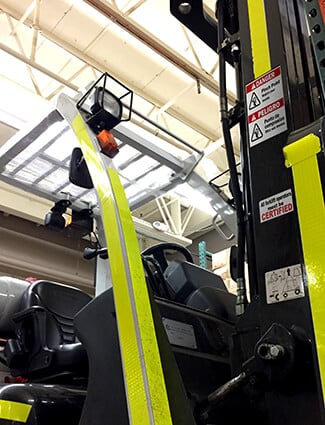Use Forklift Safety That Sticks
03
February,
2023
2 MINUTE READ

Forklifts are heavy duty equipment used for heavy duty tasks. Built tough, they sometimes bang into warehouse racks and are part of other activities that don't keep them in the most pristine condition. All this heavy action can also cause damage to labels and signs on the forklift. Over time and long use, these important safety labels can peel back, break off, and break down, whether from chemical damage, such as grease or cleaning products, to even worker vandalism. Sensible labels and signs communicate what is needed to assist workers with tasks, all while keeping safety loaded at the forefront of operations.
Forklift Safety Labels
Close to 1 million forklifts move about daily in the United States. Some estimates by forklift safety organizations project a 1 in 10 chance of a random forklift accident. According to the Occupational Safety and Health Administration, there is an average of 85 deaths and 34,900 serious injuries per year from forklifts. It is these real hazards that have called for serious rules for forklift safety.
Tony Clark was 22 when he narrowly escaped injury in a forklift accident. He was moving a load inside an ice warehouse when his forklift hit a large standalone pallet full of products. His load was too heavy, and the impact caused him to tip nearly on his side.
"I couldn't read the load limit sign on the forklift, it was so old and (there was) basically nothing left to it," Clark said. His forklift two-wheeled to one side and, luckily, came back down onto all four tires. The load stayed steadily in place. "I at least had the load centered and strapped down."
Safety labels on fork trucks and other lift-type vehicles are not required. However, they do provide reminders to workers to follow proper workplace safety measures. For example, a label could provide instructional reminders of what to do during a tipping accident: Hold tight, brace feet, and lean away from impact. Clark, now 53 and admittedly wiser, has such a label on his current forklift at a supply warehouse in Galveston, Texas. "Bilingual labels are important," he said. "And the pictograms are great for those who cannot read well."
Encourage Safe Behavior
 Though an employee has gone through forklift training, it is useful to have clearly visible reminders on safe practices. Convey safety information to forklift and lift truck operators on dangers, warnings, and cautions. Quickly replace missing, damaged, or illegible materials. For hazard mitigation, use a hierarchy of controls that include warnings, hazard communication training, and personal protective equipment. Include a prework inspection that evaluates signage and labeling for visibility of best practices such as:
Though an employee has gone through forklift training, it is useful to have clearly visible reminders on safe practices. Convey safety information to forklift and lift truck operators on dangers, warnings, and cautions. Quickly replace missing, damaged, or illegible materials. For hazard mitigation, use a hierarchy of controls that include warnings, hazard communication training, and personal protective equipment. Include a prework inspection that evaluates signage and labeling for visibility of best practices such as:
- 3-point contact: Remind workers to enter, exit, mount or dismount in safe positions.
- Fasten seat belt: Prevent ejection during an accident.
- Load capacity: Post the maximum weight the forklift can manage.
- Not in use: Remind workers to lower the fork when it's not in use.
- Use horn: Notify workers to sound horn/proceed with caution ? especially in pedestrian areas, intersections, and blind corners.
- Switches: Label the shut-off power switch, parking brake, and propane valves.
- Quick tips: Convey tip-over safety instructions and preventative tips such as to not exceed the speed limit.
- Strap down: Remind workers to use safety straps for top-heavy loads.
- Stay off: Apply "Keep Off" labels on the fork and other lifting surfaces meant for loads.
- Lock out: Use Lockout Power and Block Hoist before and during servicing.
Most forklifts are commonly made of steel, but other materials may also be used. Heavy plastics are often used on lift accessories. Whether labels need to survive constant abrasion or resist grease, ensure the right industrial label materials are in use for a durable solution that lasts.
RELATED RESOURCES

5 Ways to Make Workplace Safety Signs Stand Out
Signs really are easy to use, cost-effective, and get results. But, will just any sign do? Not all signs are ...
Read
EHS Leader Reflects on Safety, Success
Chris Laszcz-Davis had made a lifelong career at the top of environmental health and safety decisions for ...
Read
Surge in Workplace Deaths Rally Calls for Safety
Workplace safety has come a long way, yet the number of workplace deaths is increasing. Worker's Memorial Day ...
Read.png)


